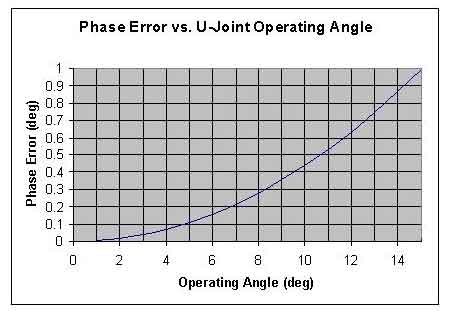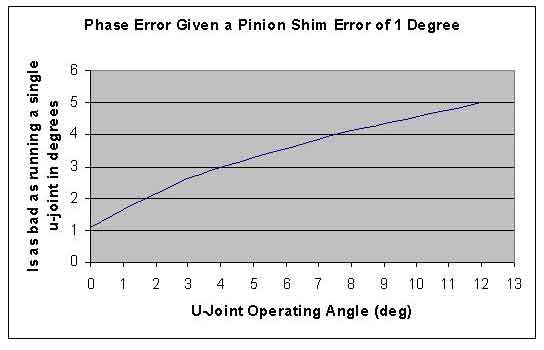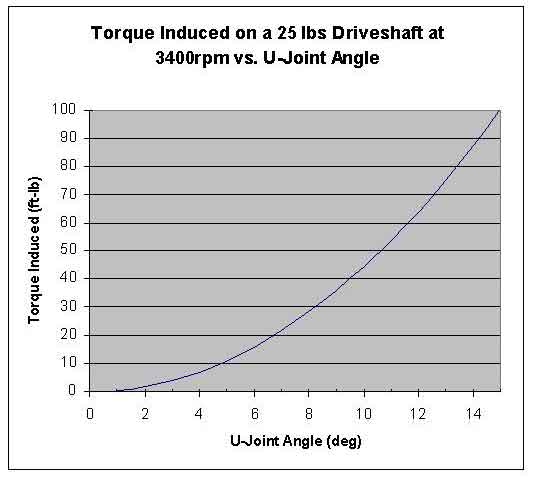What limits the angle of a 2 U-Joint setup
When I lifted the 4Runner, the stock driveshaft with the two conventional
u-joint kept vibrating. Without any shims, it would vibrate at 17mph
and several higher speeds. With a shim so that the pinions were parallel to
each other, acceleration would be fine, but deceleration would cause vibration.
I tried a shim with an intermediate angle. Vibration was no better. It was
only after a CV shaft that vibration completely went away.
There are two cause for vibration.
1. Improper phasing
If the two u-joints are not at the same angle during operation, the pinion
would speed up and slow down every
90 degrees. Theoretically, the truck would speed up and slow down 4 times
with every turn of the drive shaft. In reality, the oscillation is so quick
since the drive shaft spin so fast that you would only feel it as a vibration.
2. Inertia of the Driveshaft
Second possible cause of vibration: 2 u-joints are at the exact angle so they
cancel each other's phase error. There is no phase error at the pinion ends
of the drive shaft. Theoretically, with a drive shaft that weights 0 lbs,
there would be no problem. You would get a smooth ride. However, real drive
shafts are heavy, and have torsional inertia. Although at the output, the
pinion is rotating at a constant speed, the shaft in the middle between the
two u-joints is speeding up and slowing down every 90 degrees of rotation.
If the drive shaft is heavy, and is turning at a high speed. It would take
some torque to speed a heavy drive shaft up and down 4 times a rotation. This
extra torsional strain induced into the drive train would also cause vibration.
There is a disadvantage to a 2 u-joint setup over the CV joint.
Problem 1
The majority of the vibration will come from error in the drivetrain angle rather than from inertia of the shaft. You say wait the minute. You used shims to get the u-joints within half or one degree of each other. Even if it is one degree off, that little could not possibly cause vibration. However, if someone were to tell you after careful measurement that you have a 3 degree error in your driveline setup, then you would say obviously, that is where the vibration is coming from. You would immediately fix it.
The strange thing about mechanics is that your one degree error in a high angle driveline is in reality a 3 degrees error. If the driveshaft is running at a 4 degree , just being 1 degree off in the drivetrain angle is like being 3 degrees off if you have a constant velocity type driveshaft. You say wait the minute, you must be smoking something, show me.
The below graph shows how much phase error a u-joint have given its operating angle. The phase error is the amount that the output end of the u-joint speed up as the joint is rotated 45 deg. At 90 deg. the u-joint is again in phase. As seen, the higher the operating angle of the u-joint, the higher the phase error. Note that the graph does not lie in a straight line (linear), but rather, is curved upward. This means, the higher the operating angle of the u-joint, the much more error you have. You can deduce that at higher angles, if you make an error in shimming the pinion, you would have more phase error than at lower driveshaft angles.

So lets assume there is a one degree shimming error in the rear pinion. As can be deduce from the above graph. The steeper the angle that the driveshaft runs, that one degree of shimming error is more significant than at lower angles. If the driveshaft is running at 10 deg. Meaning both u-joints are "bent" at 10 degs. You made a shimming error of one degree at the pinion, that is as bad as running a single u-joint at 4.6 degrees. This means you just as well install a CV type driveshaft on the truck, and set the rear pinion off by 4.6 degrees. What this means is that at higher driveshaft angles, you have to be very careful in setting the rear pinion angle exactly. This means using custom made shims to dial in the exact pinion angle. However, remember that even if you set the pinion exactly right, when you step on the gas, the pinion rotates up. When you declerate, the pinion rotates downward. Most people compensate with .5 deg of downward angle so during normal operation, the pinion would be more or less at the right angle. Seeing from the graph how sensitive the driveshaft is to angle error, the drivetrain would be vibration free at a certain operating condition. This is why when I decelerate on the truck, the driveline vibrates. I had close to 1 deg of bias downward on the rear pinion. During deceration, there would be over 1 degree of angle difference in the ujoints. As seen in the graph below, at 1 degree of error on a 12 degree driveshaft, it is like running a single ujoint (like in a CV joint) at 5 degrees. Ouch!

Problem 2
At 70mph, the driveshaft of a stock 4Runner with 4.11 gear and 27.5" tire is at 3400 rpm. The amount of induced torque on the driveshaft due to phase difference assuming a 25 lbs driveshaft 3" dia running at 10 deg. would be 44 ft-lb. That is significant from a fatigue point of view because it is cycling at 6800 times a minute. From a vibration point of view, it may not be that bad. As explained above, when the u-joint is running at any angle other than straigh, the output side of the joint will be speeding up and slowing down every quarter of a turn. It takes force to speed up and slow down the driveshaft. This place an inertial load on the drivetrain.
The graph assumes the center tube of the driveshaft weights 25 lbs. Is spinning at 3400 rpm. The shaft diameter is 3", and thickness of the shaft is .1" You can see that if the u-joint is running at 14 degrees, the induced torque would be close to 100 ft-lbs. That is as much torque as the engine puts out. I would not be comfortable with that figure. My limit would be around 6 degrees. Evidently, this is what experianced people recommend with seat of the pants estimation.
